How to Use Kitchen Cabinets as a Pantry
Without fail, in each and every house we move in to, there is always one specific space that requires a complete re-imagination from what we were doing before: the pantry. In the 8 homes we’ve lived in, we have not once had a “similar” pantry layout, meaning our previous organization systems don’t nicely transfer over to the new house. Since the pantry is something we interact with day in and day out, not having a “just right” system in place usually leads to quick and total pantry chaos. And like clockwork, once that happens, I move “Figure Out the Pantry” to the top of my list. Our current house provided a challenge we haven’t encountered yet: no pantry at all! It’s something I immediately noticed when examining the pictures in the MLS listing and worried about as we moved in. It quickly became clear that we were going to have to use the kitchen cabinets as a pantry.
This isn’t my ideal situation. As such, I worked hard to make it as functional as possible and wanted to share the strategies we used (with great success!) in case you are faced with using kitchen cabinets as a pantry too!
I’ll mention up front that we are currently using 2 kitchen cabinets in addition to 2 kitchen drawers as our pantry. BUT! Today, I want to chat specifically about how to outfit kitchen cabinets as a pantry. The tips and tricks I’m sharing today can be applied to any size and number of cabinets to contain any types of food (including foods we’re currently storing in our drawers). Next week, I’ll dive deeper into those kitchen drawer strategies so stay tuned for that!
Where to Put the Pantry?
I am super particular about having everything in one spot. Whether it’s toys, craft supplies, or in this case…food…I don’t like items spread out around the house or even within a single room. It just makes for extra work and effort to find what you’re looking for. So even though we have a nice big island full of pull-out shelves and some other (more spacious) cabinets, I tried to find an area that would allow us to create the “feel” of a pantry by having all of our food in one spot. The tall cabinet next to our fridge, which also has three good-sized drawers right underneath it, was the ideal location not only for its size but also because it’s central to where we do almost all of our food prep.
Take Away: Consider these factors when deciding which kitchen cabinets to outfit as a pantry: Where are the cabinets? Are they easy to get to? Is there enough space/cabinets? Are the shelves adjustable? Are the shelves deep enough or too deep? Can the cabinets (or set of cabinets) hold what you need to store? Can you reach all the shelves in the cabinet(s)?
Supplies Featured In My Pantry
- Clear Pantry Bin With Handles
- Clear Pantry Bin
- Long Clear Pantry Bin
- Oxo Air-Tight Food Storage Container – 2.1 Quart
- Oxo Air-Tight Food Storage Container – 2.5 Quart
- Cricut Joy Smart Label
How to Make Kitchen Cabinets Into a Pantry
While I love that these cabinets go all the way to the ceiling, it didn’t take long for items to get lost on the top three shelves (since I can’t reach them without a stool). Additionally, most of the shelves were rather short, so we had to cram things in any way they’d fit. It didn’t take long before we started just stacking items and putting foods anywhere just to get the doors to shut.
Ready to see some before photos? I still can’t believe we lived with the cabinets like this for a good 6+ months!
Before I could create some order in our pantry, I knew I had some sorting and purging to do first. And as I like to do in ANY space I’m organizing (whether it’s a whole room or a tiny drawer), I relied on my simple SPACE method. This doesn’t have to be long and drawn out. In fact…in just an hour, this is what I did:
Sort
As I emptied the cabinet, I sorted all the foods into logical, intuitive categories.
Purge
Since I was going to touch every item anyway, I went ahead and made sure each item was still usable and worth keeping.
Specifically:
- Made a donation bag for foods I kept passing over week after week.
- Merged half-used bottles of spices and like oils/vinegars.
- Eliminated bulky packaging wherever possible (more on this below).
- Tossed anything that was stale or past the use-by date.
Assess
I then spent a good amount of time assessing all the different piles and categories. Specifically:
- First, I broke apart really big categories into more specific, smaller categories to make it easier to find things.
- Next, I considered which items needed to be stored in their own dedicated containers (e.g., rice, pasta,) and what could be grouped into bins and baskets (e.g., spices, canned goods, etc).
- Lastly, I considered other areas throughout the kitchen (e.g., the drawers beneath this cabinet) and what would best fit there.
These considerations allowed me to refine my categories and start to visualize what could be stored where.
Contain
Next, I considered the cabinet itself in order to identify the best solution for that cabinet.
- After taking some measurements, I determined that the 3 top shelves spaced tighter together really did allow for optimal storage. Had I moved any shelf up or down, each one would have either been way too short or way too tall for everything I needed to put in this cabinet.
- I then played around with different bins and baskets to see how I could make the most of every shelf. You’ll notice I ditched my favorite Y-weave baskets (that were carried over from our last pantry) because they really weren’t optimal for this size cabinet. After playing around quite a bit, I ultimately landed on an arrangement that not only best used every inch of available space, but also fully contained everything I needed to store in logical categories.
- With the bin arrangement set, I loaded all the foods into the clear containers and used Post-It Notes as temporary labels (not shown).
Embellish
Once I had all the foods put away, I continued to futz (<– technical term) until I was completely satisfied with the location and functionality of each item/category (e.g., less-used items on top, commonly-used items lower down). Once done, I labeled each bin with a gorgeous new label.
These labels were made with my new Cricut Joy and Cricut Joy Smart Label. You can see full instructions and access my file here!
The final step was to load everything back in, and step back and enjoy not only a really great looking pantry, but one that is also really functional!
Take Away: Kitchen cabinets don’t naturally work as a pantry. As such, you do need to spend some time figuring out how best to store the foods YOU need to store in YOUR specific cabinets. Not only consider the size and shape of each food item, but also how often you use it and how to best store it so that you can get it when you need it.
I thought for sure our pantry situation in this house was going to be challenging the entire time we lived here. But it turns out, this quick, function-focused makeover has really improved our kitchen experience for the better. I’ve just shown you how to outfit your kitchen cabinets as a pantry. Next, I’ll highlight a few things that are working really, really well!
Other Helpful Tips!
Grocery Shop First
If you are setting out to create a pantry somewhere in your kitchen or home (or even reorganize a “real” pantry), I strongly recommend you do so immediately following a full grocery trip. If you’re going to make the effort of adjusting shelves, corralling like items, and finding the right spot for your “usual” pantry stock, you need to have those items on hand. Otherwise, you might mis-judge the size/quantity of certain items and end up with everything not fitting once you are fully stocked!
Take Away: Stock your pantry first, organize second!
Eliminate Packaging
Whenever possible, eliminate the cardboard boxes and plastic/paper bags foods come in. Not only do all these colorful, busy packages create visual chaos in your pantry, but the packaging eats up potentially valuable space. You will be able to store so much more (and always see your stock on hand) if you get in the habit of “decanting” your pantry items.
Take Away: Removing packaging is a habit REALLY worth getting into. If you’re not sure how to start, I have a full guide here!
Contain It
If you’ve been reading my blog for even just a minute, you likely know that my solution to pretty much every organizing problem is bins and baskets. But this is my solution in this specific case for good reason! Bins, baskets, boxes and containers:
- Help you take advantage of shelf depth.
- Keep shelves tidier since things don’t fall over as easily.
- Are easier to pull down off shelves than single hard-to-reach items.
- Keep like items together so you know where to find them.
- Allow you to get rid of unsightly, bulky packaging (therefore allowing you to store more).
- Help corral small snack items such as granola bars, fruit cups, etc.
In our specific pantry, I can’t over-emphasize what a different the 9 clear bins made in not only keeping the space tidy, but being able to get everything down. That said: not all bins and baskets are created equal. If they don’t fit on your shelves properly or they don’t hold what you need them to hold, they aren’t doing you any good!
Take Away. Take the time to find just the right size, style, and type of baskets for your shelves and specific foods.
Used in our pantry: Clear Bins | Handled Clear Bins | Oxo Containers | Long Clear Bin
Handles are Helpful
I cannot easily reach the top three shelves in our “Pantry Cabinet,” so when I was looking for bins and baskets for our shelves, I intentionally looked for ones with handles (that still fit our cabinet depths). These handles make it possible for me to pull down each and everything in this cabinet without a stool!
Take Away: Baskets with easy-grab handles are a great way to take advantage of really high shelves!
Go Clear
So… a few weeks ago, I did a whole post about how to hide basket clutter. And you might remember that while I was outfitting our playroom baskets with faux fronts, I also made cardboard fronts for these clear pantry baskets. Interestingly enough, it took me about 0.2 seconds to realize I didn’t like the solid fronts in the pantry! Why? Because I want to be able to make my grocery list by quickly glancing at my pantry and seeing what’s out. I don’t want to have to pull down each bin just to see if I have peanut butter on hand or if we’re running low on spaghetti. Although some canned goods are stored toward the back of the bins, I can usually still see what we have on hand without pulling anything down!
Take Away: Clear containers not only look really clean, fresh and pretty but they also help you keep tabs on your pantry stock at-a-glance.
Don’t Stack Too Deep
Long-time readers might remember we once had a super deep pantry (I even showed how to take advantage of that depth without losing things here). However, in the case of less deep kitchen cabinets, I don’t recommend stacking too deep. Not only can it be harder to get things out of cabinets if they’re buried, but it can be really difficult to even see what you have on hand. In the event that you can or need to stack items in front of each other, consider varying the heights (short in front, tall in back) so that you can always see everything on hand.
Take Away: Even if you don’t corral things into bins, using the shortest-to-tallest strategy can work for a lot of different items: pantry staples (e.g., flour, sugar, etc), cans and sauces, jars and bottles, spices.
Be Flexible
At the top of this post, I mentioned I wanted all of our food items in one single spot. But that just wasn’t realistic. A single cabinet (and the two drawers I’ll show you next week), just didn’t provide the space we needed for some of our bulkier things. For example, cereal boxes and bags of chips. So right across from the refrigerator is one lower cabinet that we adjusted to hold these bigger items. This is not my “picture perfect”/everything-in-one-spot solution. However, its size and proximity to the other cabinet made it an obvious choice for these spill-over items!
Take Away: If your kitchen doesn’t have an existing pantry, you will likely need to get creative and be flexible in your storage solutions. Consider out-of-the-way cabinets, coat closets, and garage/basement shelves for non-perishable, bulky or back-supply items.
Consider Your Drawers
Finally, kitchen cabinets aren’t your only alternative for carving out pantry space. Kitchen drawers, especially deep ones, can be outfitted to hold a lot of food too…see our drawers in detail HERE!
I’m not gonna lie…not having a pantry was kind of a bummer to me. Not only do I love a good, organized pantry, but our family has become accustomed to snacking and cooking from a central food location. Using our kitchen cabinets (and drawers) as a pantry took a little while for me to wrap my brain around. But once I finally took on this organizing project and identified some really functional solutions that are truly working well, I will admit not having a pantry doesn’t bother me one bit anymore! It’s just yet another example that smart organizing solutions can help you make sense of pretty much any space!
Other Great Kitchen Storage Solutions
Ready to organize the rest of your kitchen? I’ve got you covered with more easy solutions!- How to Organize a Pantry
- How to Organize Baking Pans
- How to Organize Kitchen Drawers
- How to Organize Corner Kitchen Cabinets
- How to Organize Upper Kitchen Cabinets
- How to Organize Cabinets Under the Kitchen Sink
- How to Organize Small Appliances Inside Kitchen Cabinets
- How to Organize Spices
- How to Organize Coffee Mugs
- How to Organize K-Cups
- How to Organize Recipes
- How to Organize Ziplock Bags
- What to Do with Dirty Dish Towels
- How to Make Pantry Labels
If you too have to use kitchen cabinets as your pantry, I hope this post gave you some good ideas. Like I said, next Tuesday, I’ll give you a closer look inside our kitchen drawers. But first, back here on Friday, I have a fun and so easy craft project perfect for any book lover! See you then!
Megan


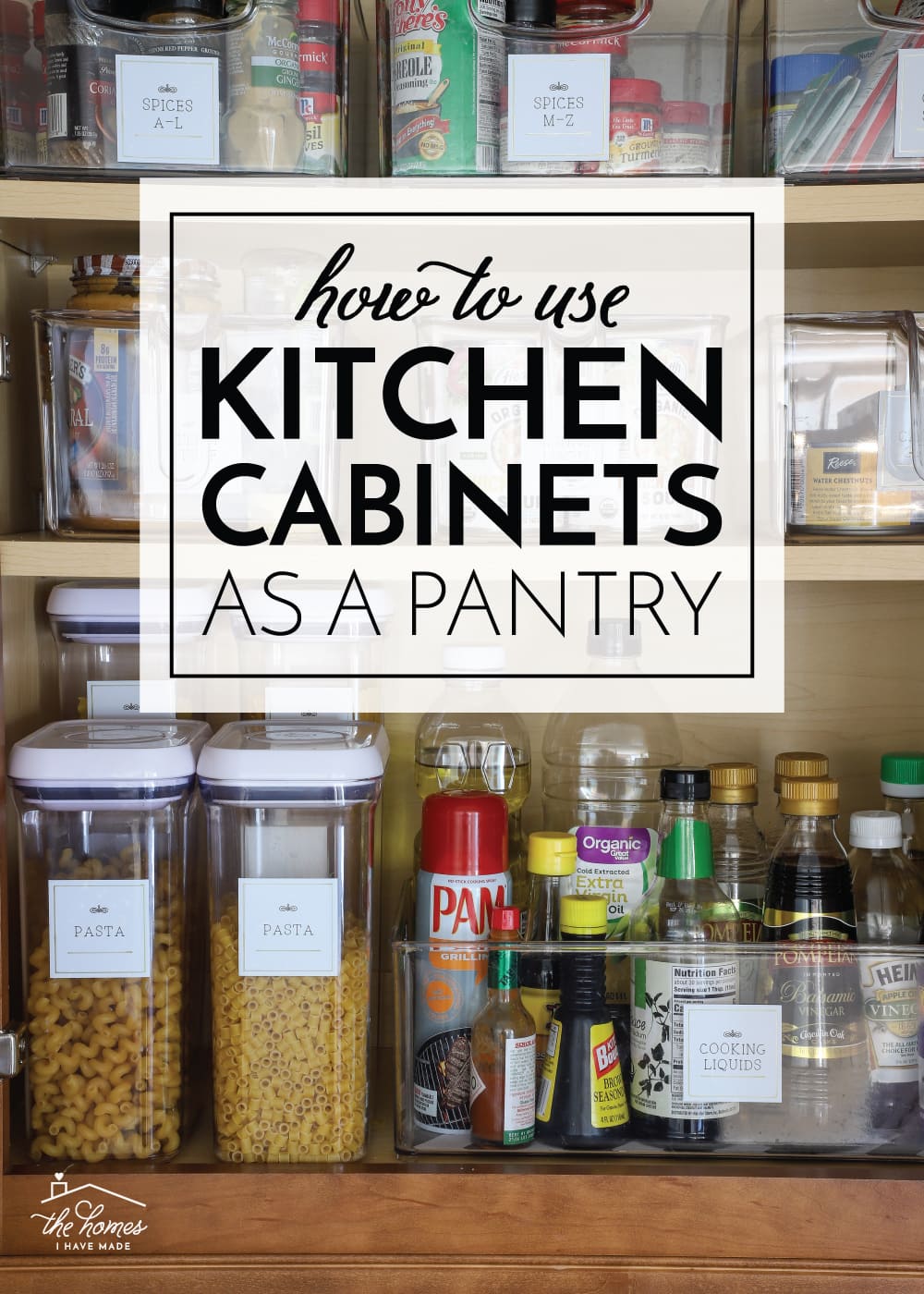
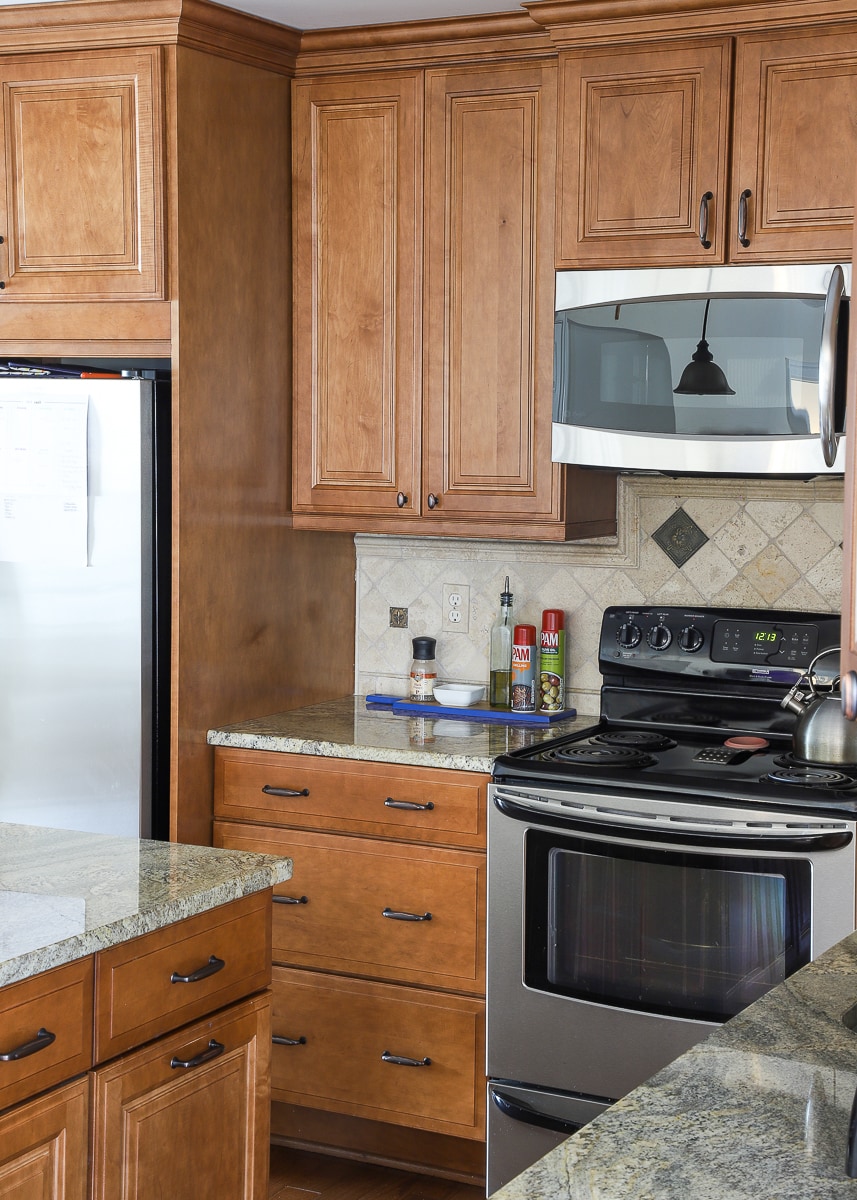
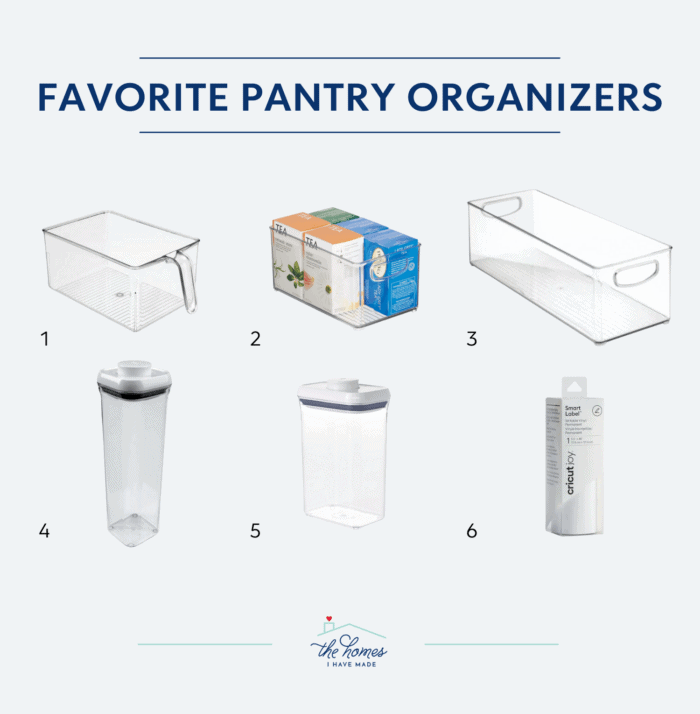
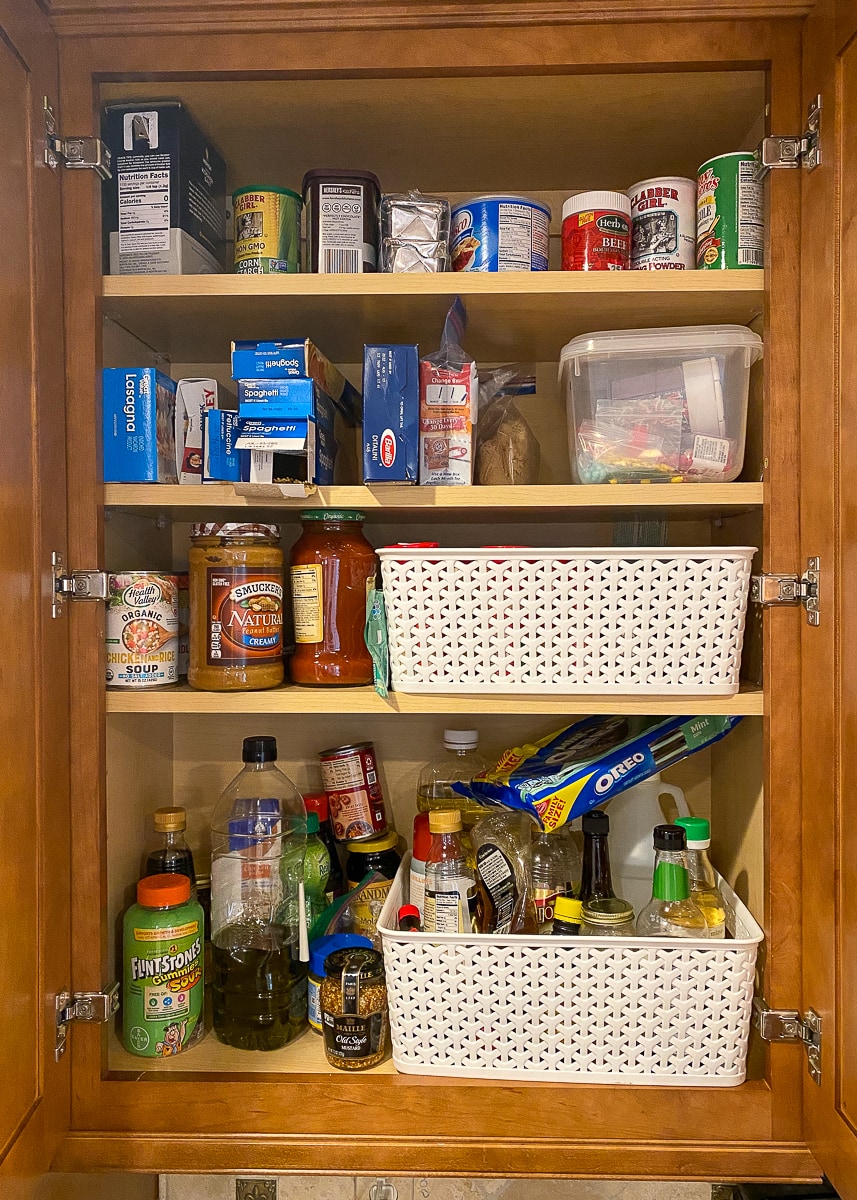
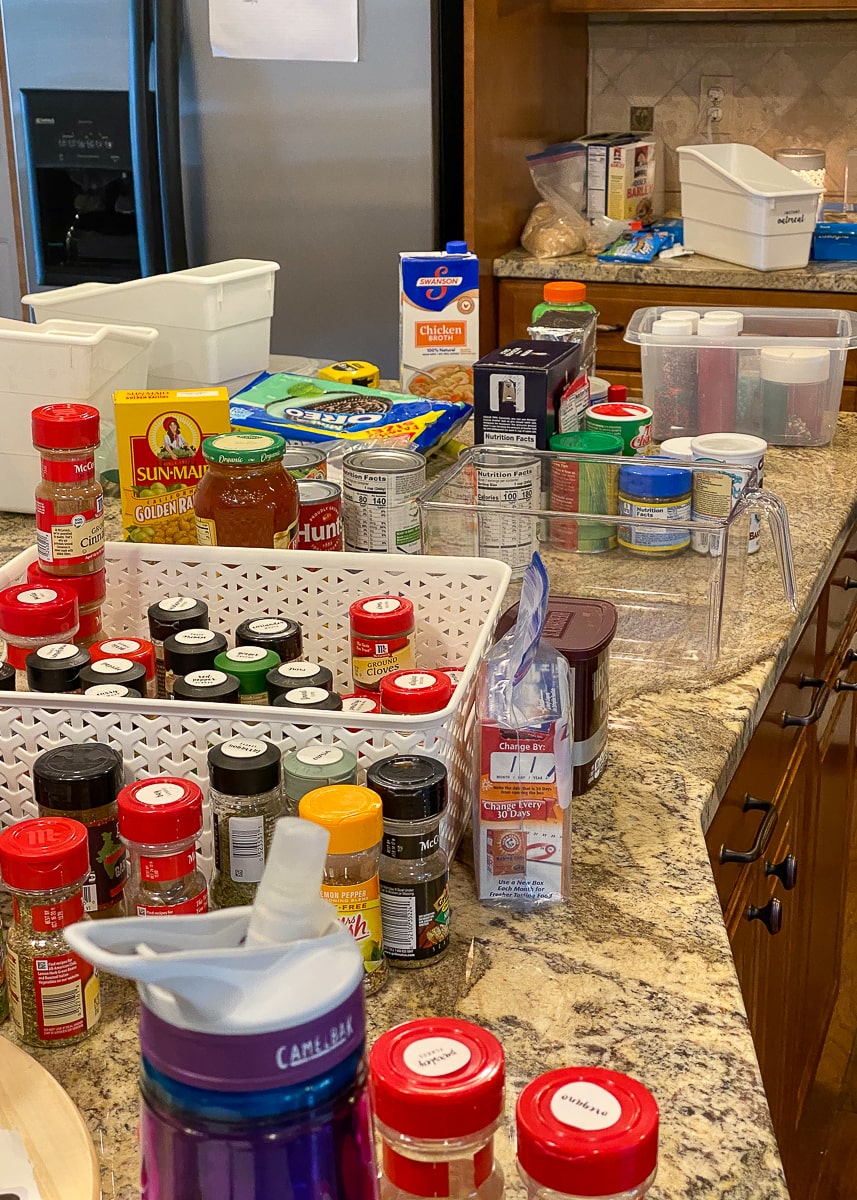
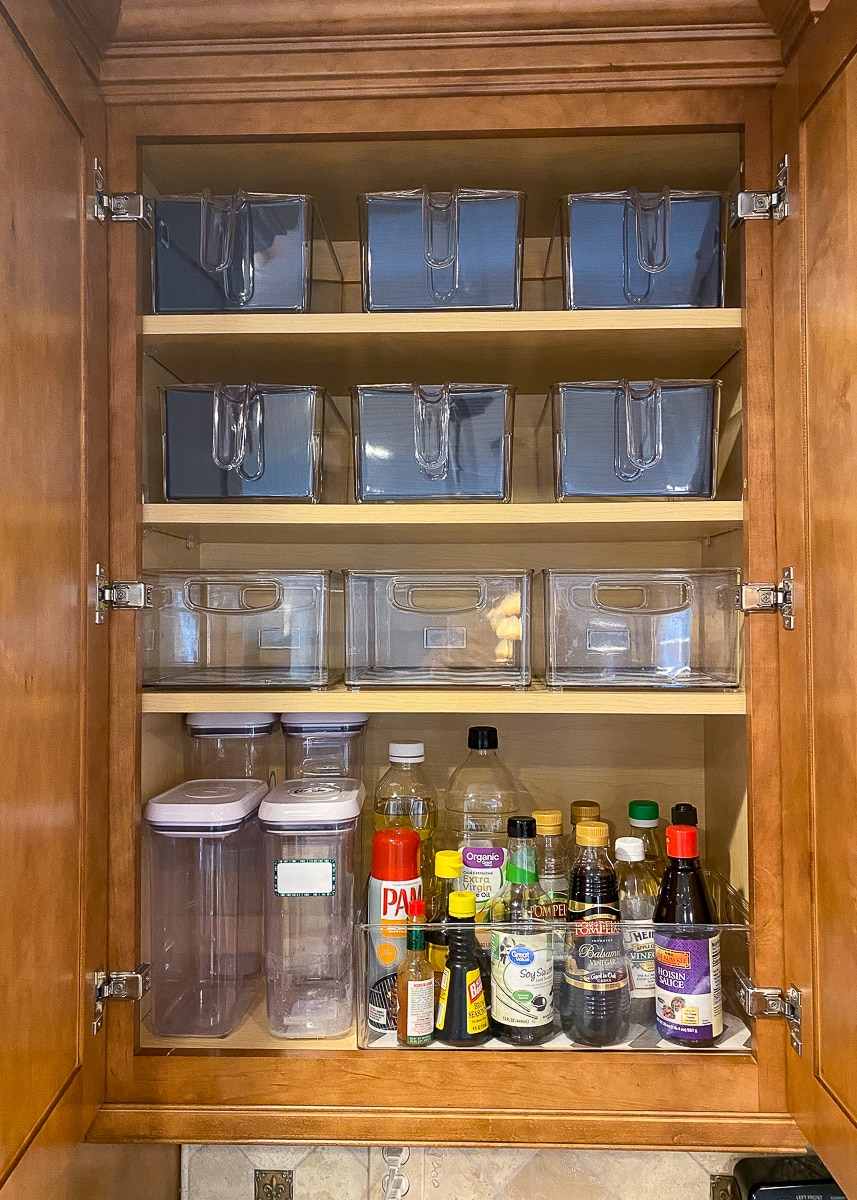
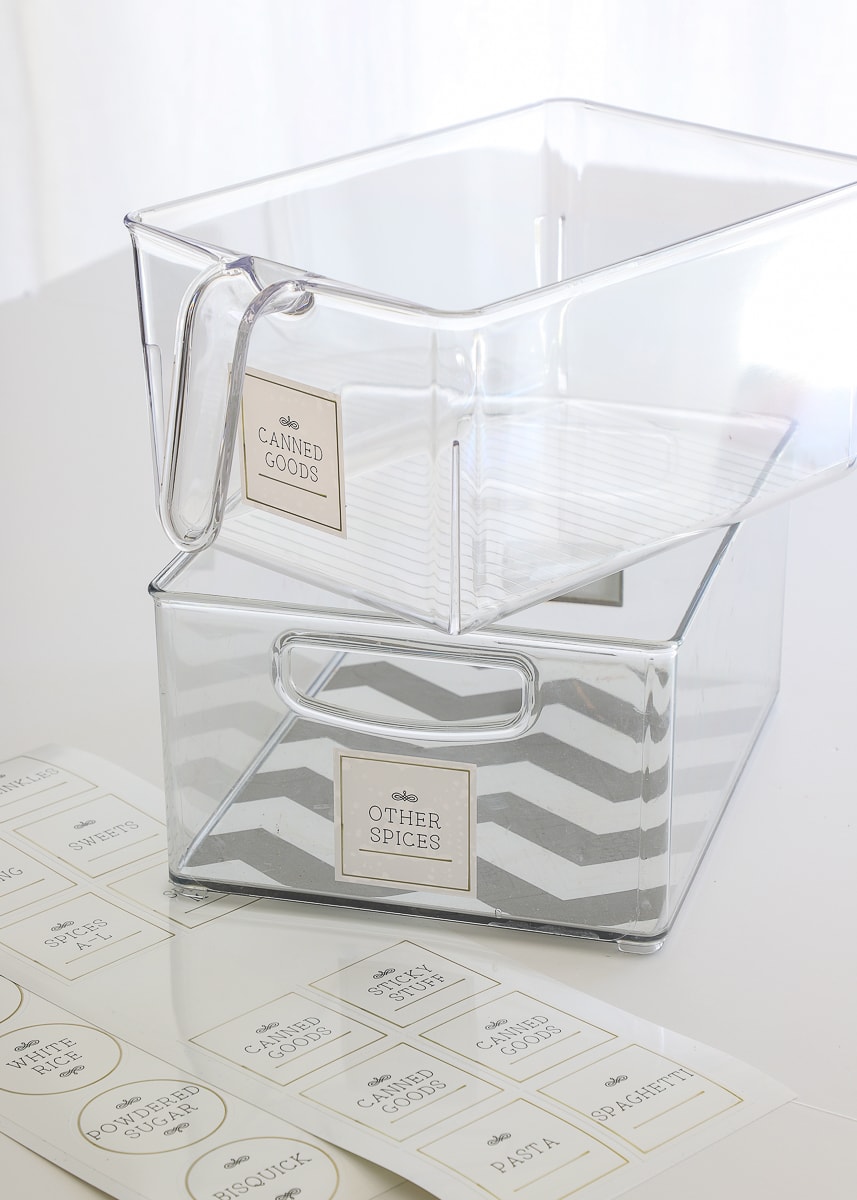
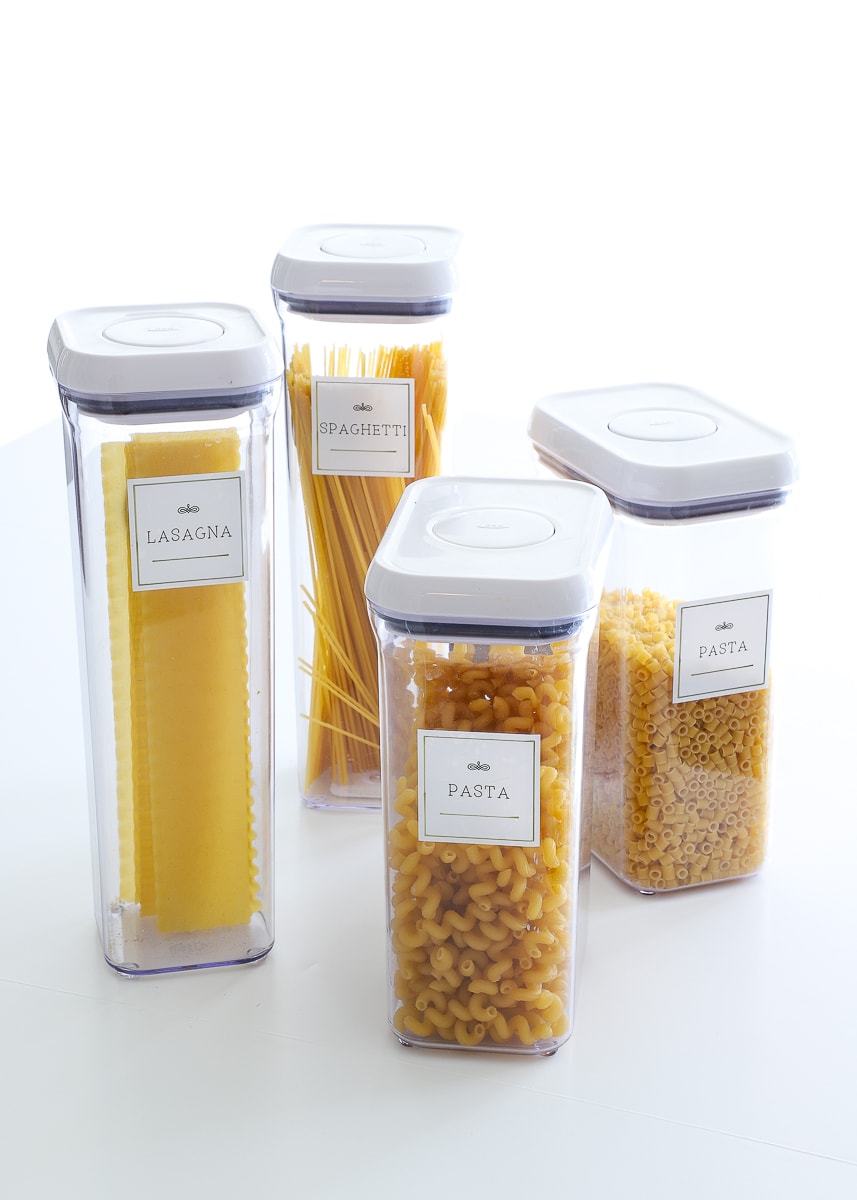
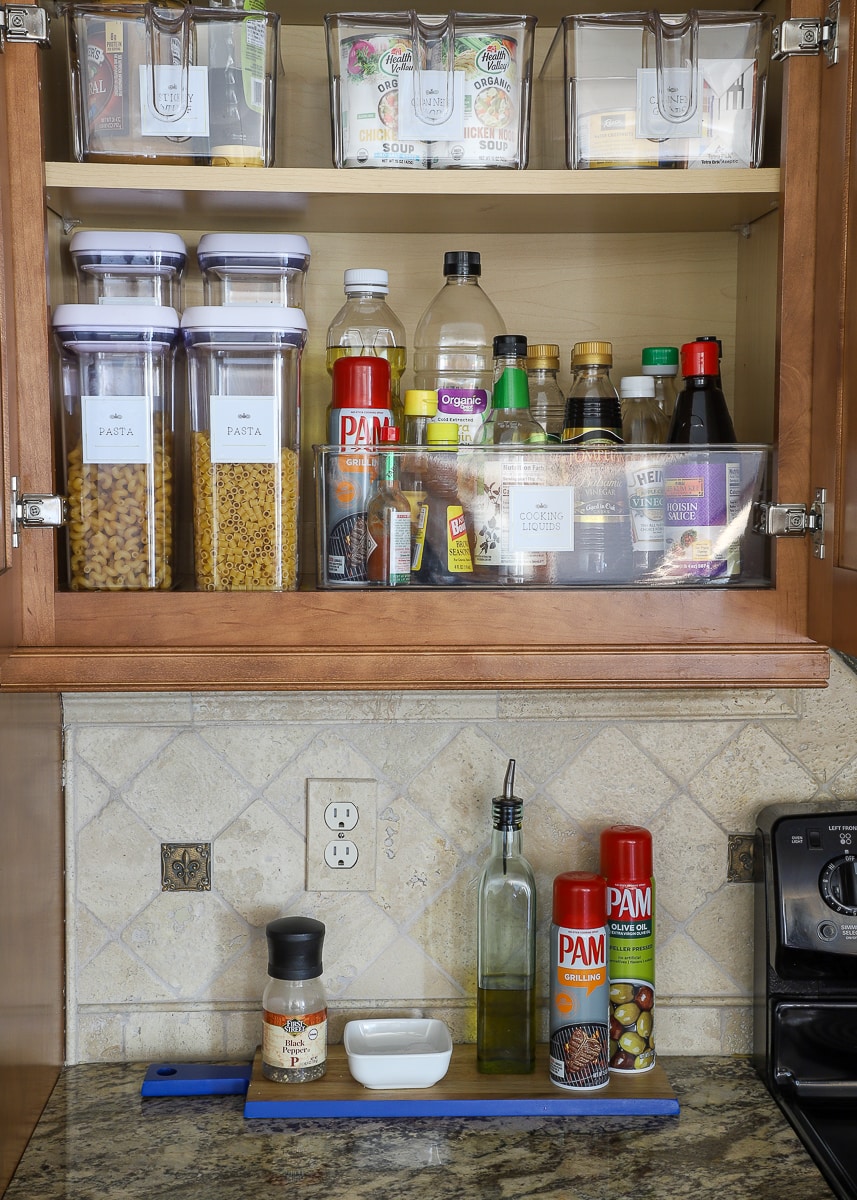
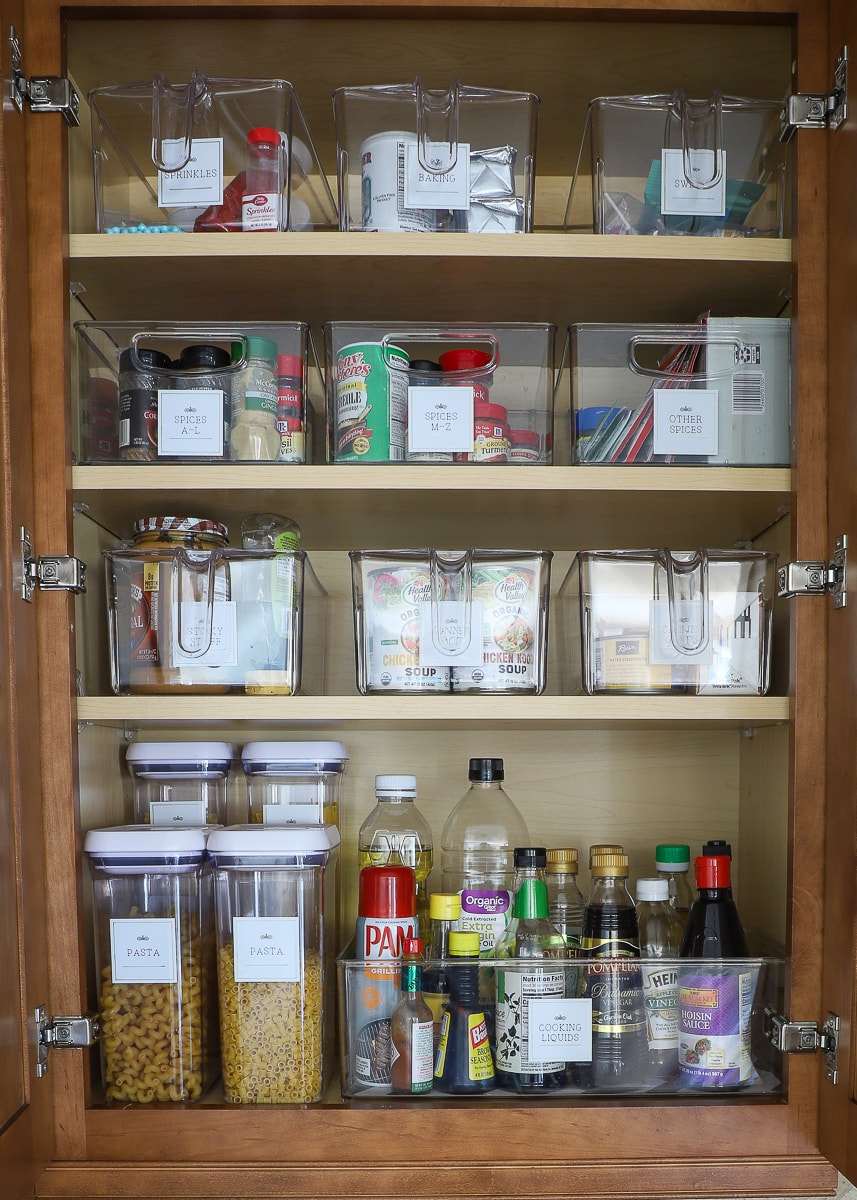
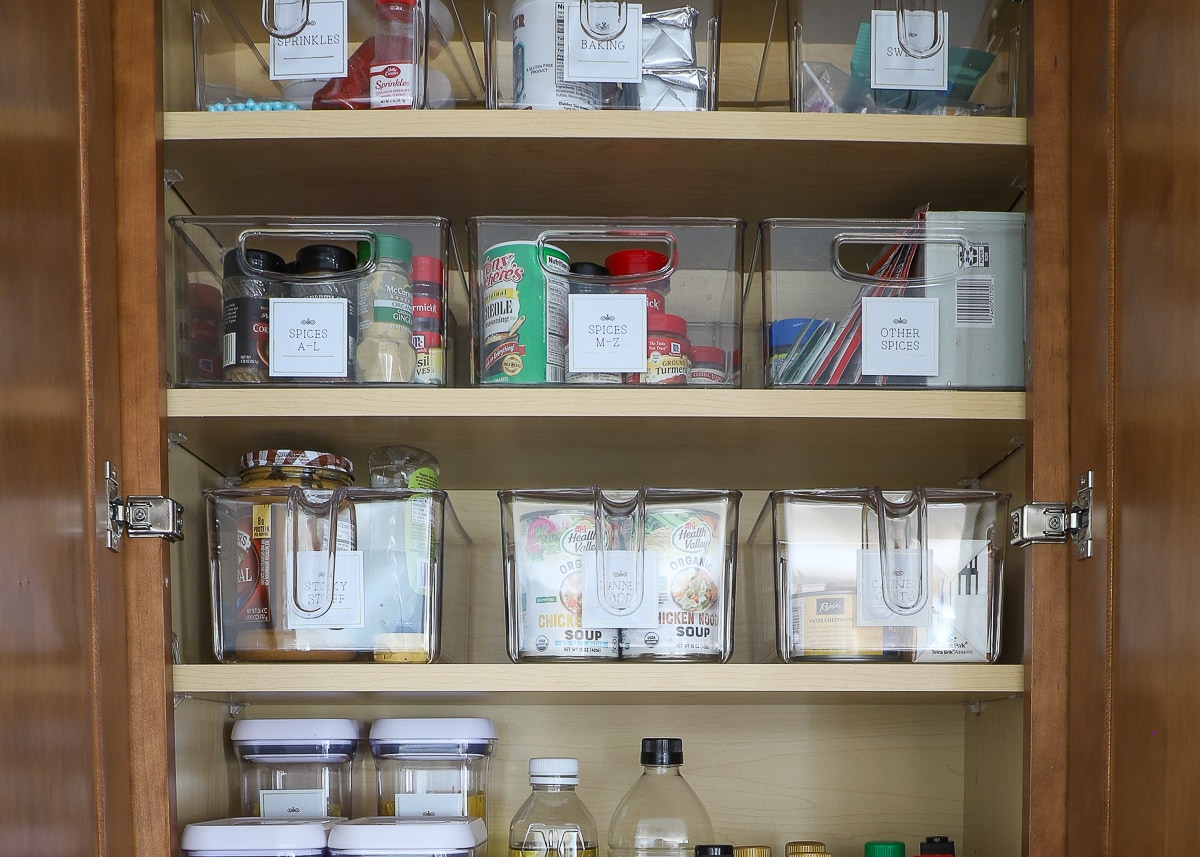
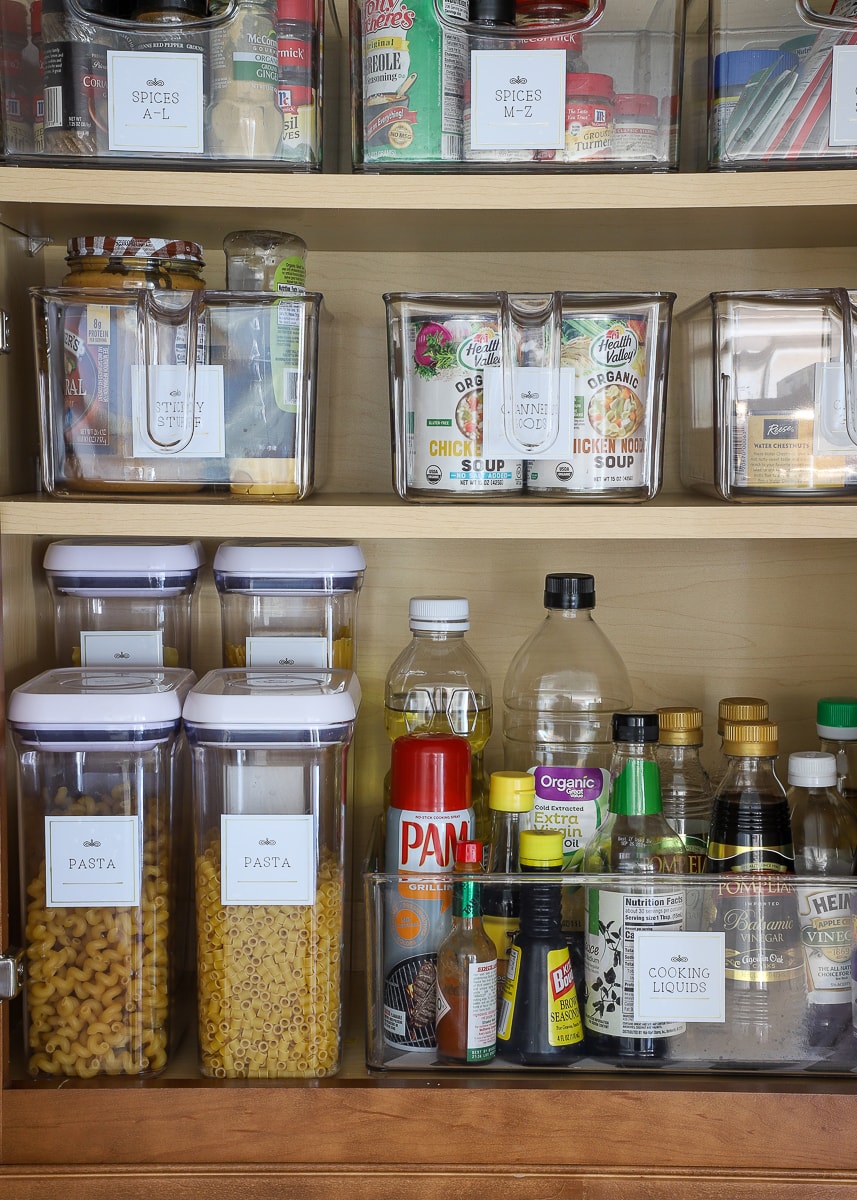
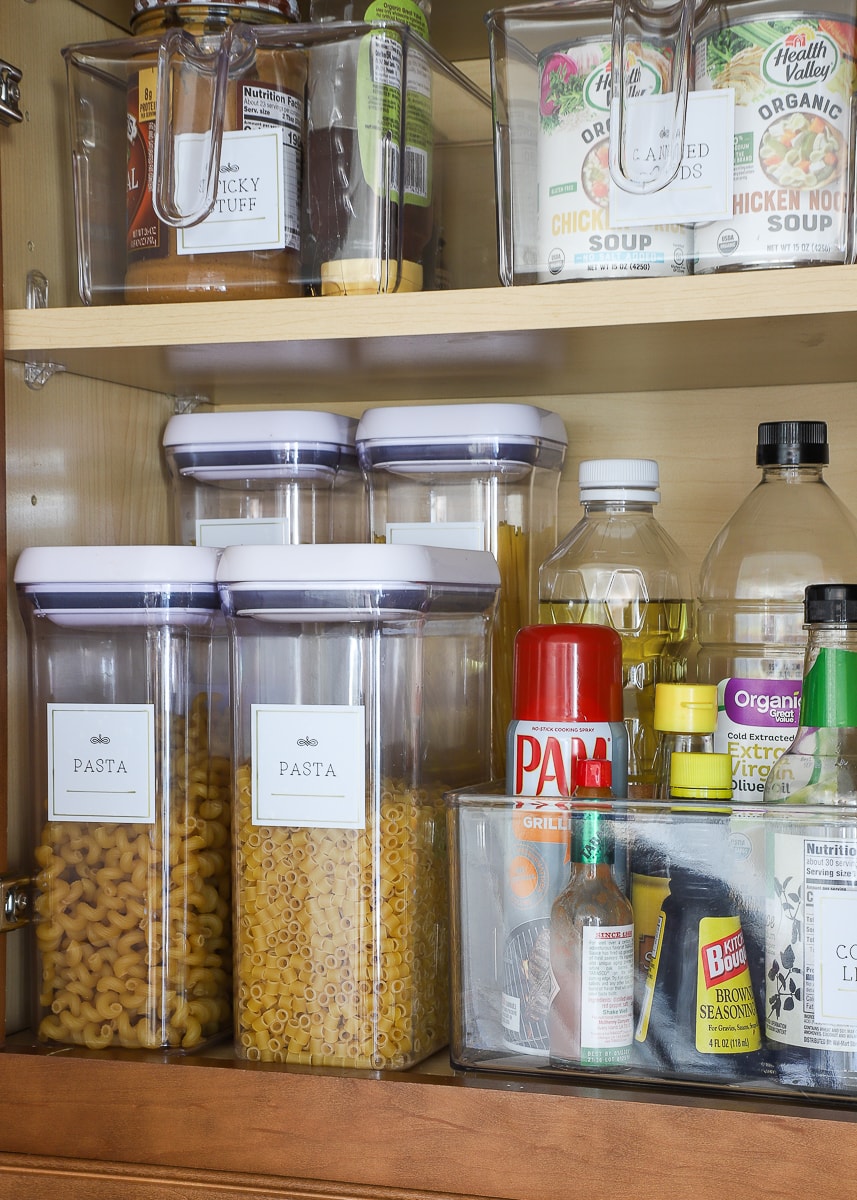
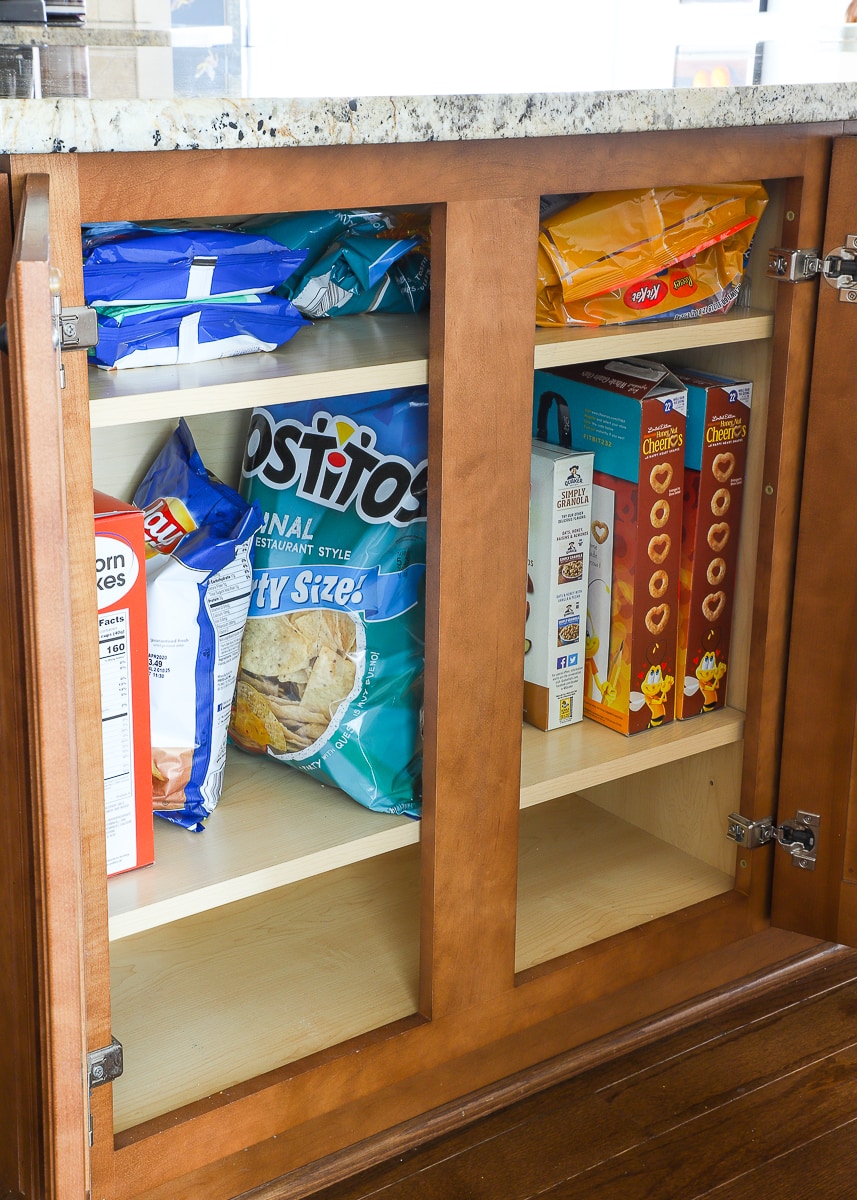
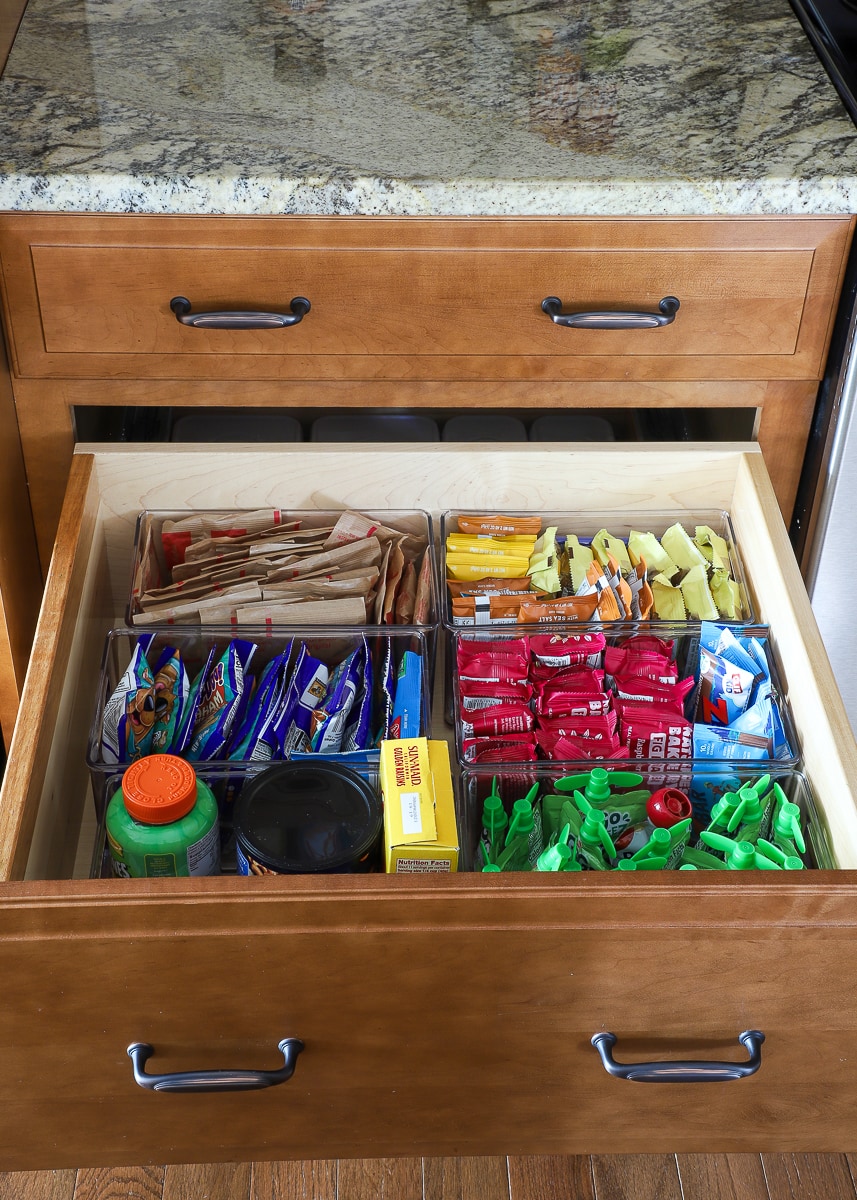
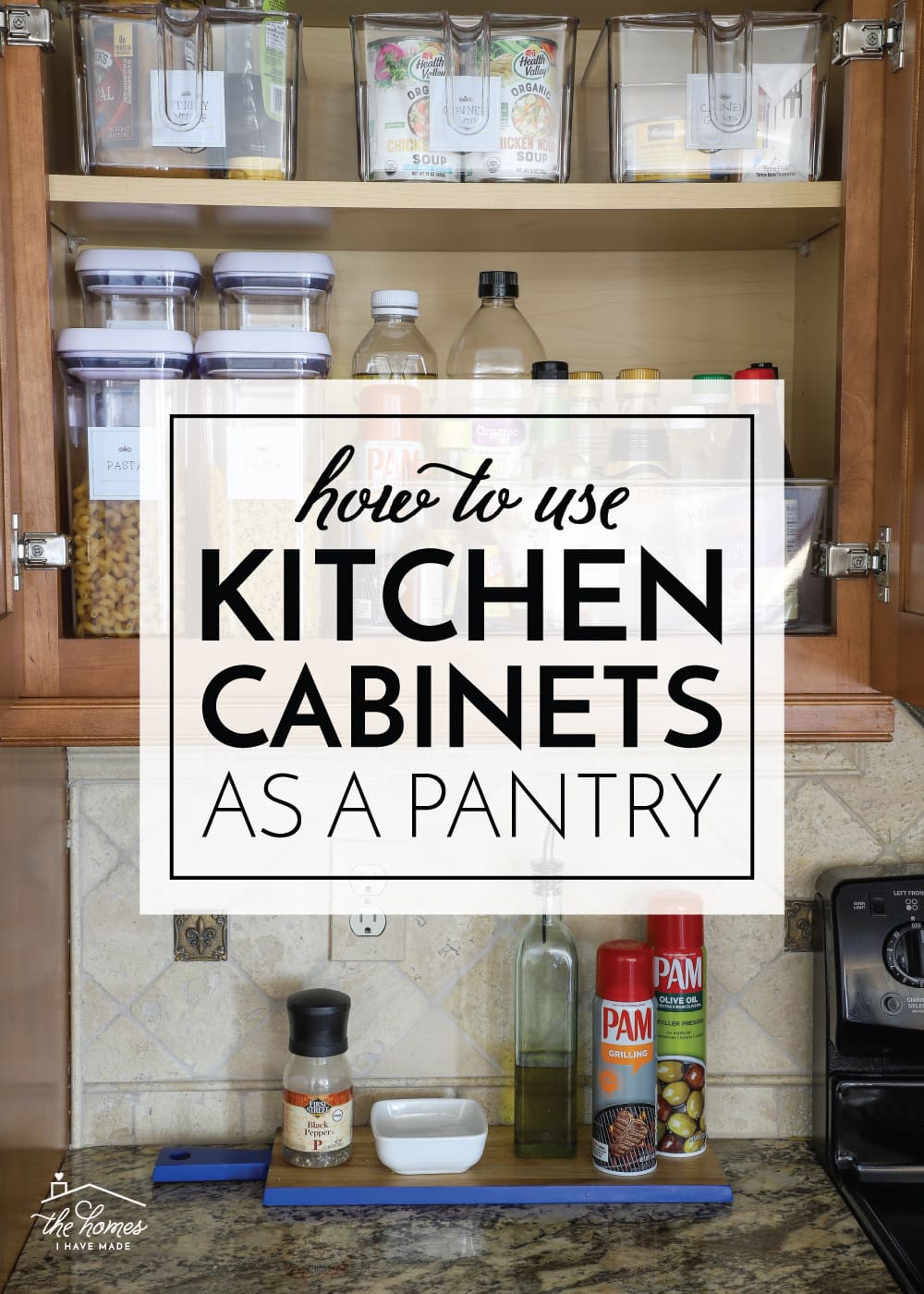
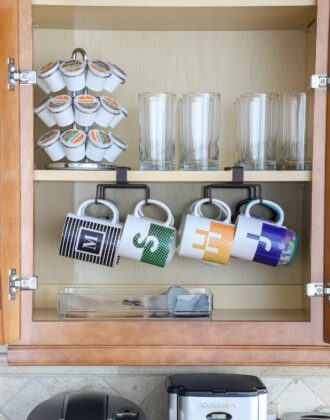
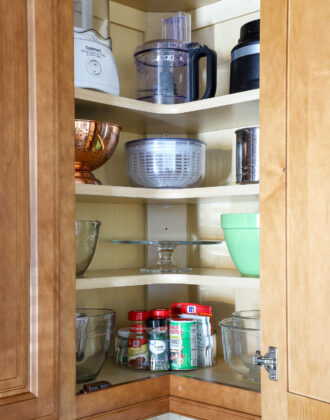
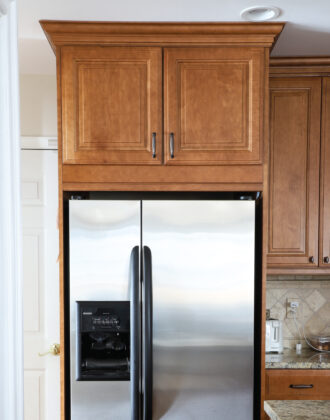
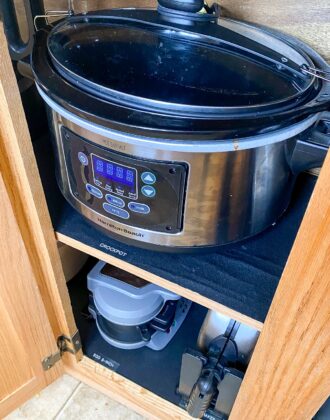

25 Comments on “How to Use Kitchen Cabinets as a Pantry”
Yes, it’s a problem. I have never had a pantry. I manage now by keeping everything I use to bake (including sheet pans and cooling racks) in a lower cabinet, and other dry food in an upper that is a stretch–I’m short. I can only reach the upper left by crawling from a step stool onto the counter, so that’s canning supplies, leaving me 2 shelves for the other stuff. I eat mostly fresh food, so I have managed to make it work. I keep dried beans and nuts on the bottom shelf, the few canned goods I buy (tomatoes, tomato paste, and pumpkin), salad dressing and cereal in the middle.
If there’s any change in what or how I buy, it causes a LOT of downstream ripples. The only kind of cereal I like is Weetabix, and no local store is reliable about stocking it. I finally decided to buy it online, and with the cost of shipping, a case at a time. Figuring out how to get 12 boxes in that cabinet was an exercise in creativity. And then my cat had to go on wet food, and since it made (again) no sense to buy less than a case, I had to find room for 24 cans of cat food.
Maybe I should take up Tetris–my talents clearly lie in that direction.
Ha! Yes, it sounds like Tetris is your skill set!!!
Yes – modifying what you buy to fit your space should absolutely be a tip I included. We’ve certainly had to do that too. I don’t buy as much back stock as I used to because we just don’t have the room for it! But…it also means food isn’t getting lost or wasted either, so that’s a good thing!
Happy weekend!Megan
I like “futz” and “sticky stuff”. A lot of these strategies are one’s I’ve used as well, like the baskets of like items and having everything near the prep area, which is reassuring. I now feel like I’m not missing a key piece of information, it really is just annoying not having a pantry. I’ve done Margaret’s tip too of just buying way less stuff and not veering from the staples too far. It limits the new recipes to try, but it also limits the “now what do I do with this nearly full bag of flaxseeds” conundrum.
We don’t have a pantry in our current rental, so we’re using a coat closet a bit outside the kitchen. We put small 2 shelving units in there, and while it’s deep and harder to access the back, I’m grateful for something… even if I do miss having a coat closet!
So helpful. In Europe houses are much smaller than in the US and kitchens hardly ever have a pantry. These tips are wonderful for small European kitchens. Thank you!
Love
Martina
So glad you found these ideas applicable to your lifestyle and home!!! Hope they help!
Thanks!Megan
Great ideas here! This is like the kaizen 5-S approach my spouse uses at work in the manufacturing environment. Going to share this with him. We just moved to a new 4 bedrm house & storage is quite the challenge in a rental! Our laundry is situated in a large linen closet in a small bathroom! Any tips for shelving & how to manage the sprawl would be greatly appreciated.
Hi there!!
I’ve got a couple different laundry posts you can check out here:https://thehomesihavemade.com/2019/02/tips-tricks-for-organizing-a-small-laundry-room/
https://thehomesihavemade.com/2015/09/simple-sweet-laundry-room-reveal/
https://thehomesihavemade.com/2015/09/organize-this-laundry-supplies/
Hope that gives you a few ideas! Good luck in the new house!!!Megan
I needed a a pantry to the point of carving out space for one. We have an older home which had a formal dining room to the front of the kitchen and a breakfast area and a small laundry closet to the rear of the kitchen. We repurposed the formal dining room into a real laundry room and a walk in pantry. My breakfast area is now 12 x12 with the laundry closet removed and I have a real laundry room with cabinets, shelves and a folding counter. My walk in in pantry is 7 x 7 with narrow shelves on both sides and a counter to the back with plugs in. My son and husband did the work and we bought used cabinets on Craigslist so I have less than $1000 in the whole project. More than worth it. I’ve never had anything but broom closet sized pantry before and this has changed my life!
Hey Jayne!
Wow – that arrangement sounds AMAZING! Yes, I would imagine this pantry/laundry setup is much more useful than a formal dining room! What a great use of space and how awesome you could do it all on such a tight budget!
Thanks for sharing!Megan
In our 22 years moving around with the military I dealt with quite a few different pantries. As a fairly short person one thing I learned to do is put the tallest items on the top shelf (where weight isn’t an issue) and make my lower shelves closer together. This usually allowed me to reach the top shelf. Of course, as with any solution, it doesn’t always work, but often enough that it was a go-to option for me. Also I often had an “immediate use pantry” in the kitchen and then the “back-up pantry” somewhere else (laundry, garage, utility space, etc.) That way I could still purchase in bulk AND keep everything I needed in the kitchen.
Wonderful concept but please give credit to the original creator of the concept of SPACE; author and professional organizer Julie Morgenstern. Her book defines SPACE as
Sort
Purge
Assign (a home)
Containerize
Equalize
Changing a word or two is still considered plagiarism. Thank you
Organizing from the inside out – Julie Morgenstern
Hi there!
Thanks for chiming in here. I’ve actually never heard of this author nor read her book. I didn’t plagiarize in the slightest…it’s very possible different people come up with the same concept! In fact, I’ve been told about another professional organizer who uses a similar method!
I was an English major in college and would certainly never plagiarize.
Thanks!Megan
This is super helpful! I like seeing how others deal with this. We have the same situation — HUGE kitchen, tons of cabinets… no pantry for some reason. So I use cabinets, the appliance barn holds larger items (appliances are moved to a deep lower cabinet with more room) and deep drawers. Two shallow drawers are my spice rack, since I have dividers in there for it. But our cabinets have short shelves so finding properly sized containers is hard.
But I may have to try some of these ideas. We do use some of these already — my less-used baking items are on the upper cabinet, in baskets and decanted into containers to save space and keep them fresh. But the rest re not.
Hi Stacy!
So glad you found this post helpful! You’ll have to keep me posted if any of these ideas work in your cabinets!
Thank you for your organization emails. I have learned that I need to learn more and be more proactive in my home regarding organizing. Your home and pictures are inspiring. Thank you, again.
Alice Cornelson
You are most welcome, Alice!
Your plan is just the right one practical and easy to follow much thanks
So glad you find this process helpful, Masuma!
Thanks for stopping by!
Megan
Love your ideas! Although in our house those chips (and other treats) go way up on the top shelf. LOL
We are also a military family and just completed a move in May. Our kitchen has tons of cabinets but no pantry. I have thrown everything in the cabinets until I could think of a better way to organize. Your tips were very helpful, especially for the clear bins with handles. I also like the idea of using those slanted organizers for spices and taking things out of their packaging so items are more uniform.
Hi Again!
So glad you found this post helpful! We’ve been pantry-less for quite a few houses, and it’s a total nuisance! Our next home has a nice, big traditional pantry and I can’t wait!
I will say – those handled bins for higher shelves were perfect!
Megan
My hubby and I have lived in the same house for the past 39 years and our home , garage, wood shop, & my area above wood shop, all look like we have been SAVING for 100 years. Last year I got in and started thinning the herd, but the more I work at it the worse it all looks! At 78 years old we don’t seem to have the energy to go thru and clear out our own clutter, but STUFF from our Mom’s and a couple of Uncle’s, too.
I try to clear off counters and dressers, but suddenly every FLAT SPOT in the house is covered up again in STUFF. We need a Team to help us uncover all the stuff that needs to be organized or gotten rid of. Honestly, the more I try to do the worse it all looks! Duplicate on purpose! Thanks for listening.
I also have this problem. While I was in the military, I moved every year or two, keeping my household “inventory” to a minimum. But following retirement, I have now been in the same house for 30 years and I need to move to a different state. I have tried to organize and purge craft, camping and scouting supplies, but I face a monster of a task to clear out 30 years of accumulation of toys, tools, clothes, etc., etc. by myself, which is way beyond my energy level. Any guidance on a major purge without filling the local landfill with useable stuff would help.
Wow, great article! I love the organization of the piece with subtitles and clear links to storage items. I am currently struggling with a pantry so deep it’s useless and pondering the decision to move all the food to the kitchen cupboards. Thanks!